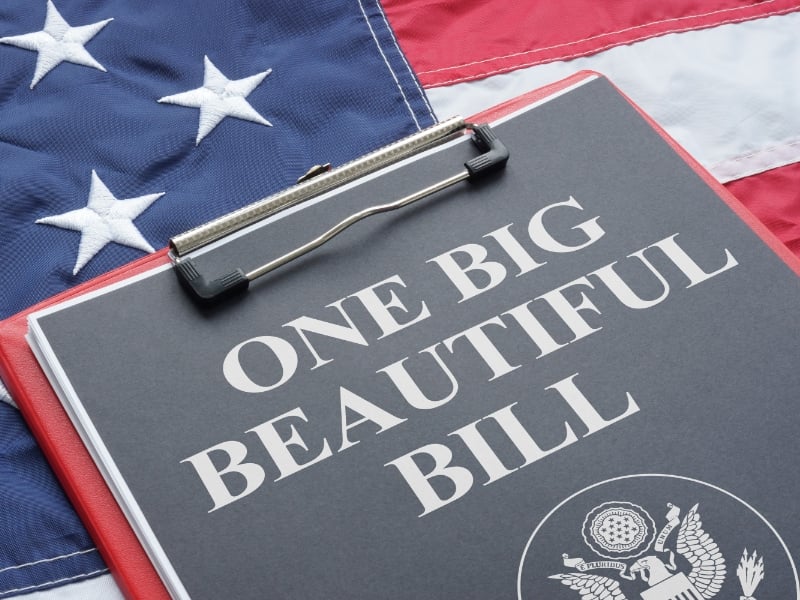
On July 4, 2025, President Trump signed into law the One Big Beautiful Bill Act (OBBBA). The recent enactment of the OBBBA includes several key changes for high-net-worth individuals and their families. The Bill itself is more than 870 pages long, but below we will summarize some of the high-level changes.
Changes to Income Tax, Deductions, and Credits
Lower Income Tax Rates Extended
The individual income tax brackets introduced by the 2017 Tax Cuts and Jobs Act (TCJA) have now been made permanent. That includes the 37% top marginal rate (instead of returning to 39.6%) and lower rates across most tax brackets. The bracket thresholds have also been adjusted upward for inflation, which may help reduce your taxable income if your earnings have remained steady.
Higher Standard Deduction
The near-doubling of the standard deduction continues instead of ending after 2025. The standard deduction ($15,750 for single filers and $31,500 for married couples filing jointly in 2025) will be adjusted each year for inflation. This may mean fewer taxpayers will need to itemize deductions at all.
State and Local Tax Deduction (SALT) Cap Increased
The cap on SALT deductions was not eliminated, but it is getting a temporary boost. This is retroactive to 2025, raising the cap from $10,000 to $40,000, offering potential relief to households in higher real estate tax states. The raised cap is effective until 2028, which at that time would revert back to TCJA’s limits. However, the expanded deduction begins to phase out for taxpayers with incomes above $500,000. The exact benefit will vary based on filing status and household income.
Expanded Child Tax Credit
The CTC increases to a maximum of $2,200 per child with a refundable amount of $1,700 in 2025, indexed for inflation in subsequent years.
Starting in 2026, eligibility for the full credit amount depends on several factors: lowincome families must owe at least $1,700 in federal income taxes to receive the full benefit, and the credit phases out for individuals earning over $200,000 and married couples filing jointly earning over $400,000. A separate $500 nonrefundable credit remains for other dependents who do not qualify for the full amount.
New Car Loan Interest Deduction
Starting in 2025, taxpayers may deduct up to $10,000 in interest on new auto loans, though the benefit phases out for individuals earning over $100,000 ($200,000 for joint filers).
The deduction applies only to vehicles with final assembly in the U.S. and is available through 2028. The deduction decreases by $200 for every $1,000 of income above the threshold. For example, a single filer earning $120,000 could deduct $6,000. This deduction is an above-the-line deduction, meaning you can take this deduction even if you do not itemize.
Temporary Tax Break on Tip Income
From 2025 through 2028, eligible workers can deduct up to $25,000 per year in reported tip income from their federal taxable income. The break applies to employees who receive tips subject to payroll tax withholding and earn less than $150,000 ($300,000 for joint filers). One thing to note is this deduction is not available for married filing separate status.
A list of qualifying tip-based occupations will be published by the Treasury Department this fall.
Provisions for Wealth Transfer, Investments, and Retirees
Temporary “Senior Bonus” Deduction Introduced
Americans age 65 and older may qualify for a temporary $6,000 “bonus” tax deduction starting in 2025. This is a similar deduction to the old personal exemptions that have now since been eliminated and is treated as an above-the-line deduction, outside of itemizing. The full amount is available to individuals with incomes of up to $75,000 ($150,000 for joint filers) and phases out for those with higher incomes.
Estate and Gift Tax Exemptions Increased Permanently
The new tax law permanently raises the estate, gift, and generation-skipping transfer tax exemption to $15 million per person beginning 2026 (currently over $13 million per person in 2025). This number is set to adjust for inflation each year. This avoids the planned 2026 rollback and allows individuals to pass on more wealth tax-free.
Capital Gains Brackets Adjusted for Inflation
Capital gains tax brackets have been adjusted for inflation, allowing more investors to stay in the 0% or 15% tax range. For 2025, individuals can have up to $48,350 in taxable income, and married couples filing jointly can have up to $96,700 and still qualify for the 0% rate.
This change offers added flexibility for individuals seeking to sell appreciated assets without incurring higher tax liabilities.
Other Noteworthy Changes
Charitable Donation Outside of Itemized Deductions
The bill allows an additional deduction for taxpayers that do not itemize to claim up to $1,000 for single filers, $2,000 for married filing jointly on charitable donations. This is an above-the-line deduction and is not indexed to inflation.
Alternative Minimum Tax Relief Made Permanent
The new law permanently extends the higher AMT exemption levels set by the 2017 tax cuts, helping more households avoid the AMT. The exemptions will continue to be adjusted for inflation, but the phaseout rate for higher earners increases from 25% to 50%, meaning the benefit tapers off more quickly for high-income taxpayers.
Major Medicaid Changes
OBBBA also includes major changes to Medicaid, including:
- Cuts of roughly $1 trillion in federal Medicaid funding over the next decade.
- Work or volunteer requirements (80 hours/month) and frequent eligibility checks for U.S. citizen recipients.
- Tighter restrictions on who qualifies for coverage and what services are included.
New “Trump Accounts” for Child Savings
In the new bill, children born in the United States between 2025 and 2028 who have a Social Security number will receive a one-time $1,000 federal deposit into a new taxadvantaged savings account, nicknamed a “Trump account.” These accounts are opened automatically once a parent files taxes and meets eligibility requirements.
Parents can contribute up to $5,000 annually, and employers may contribute up to $2,500 without it being considered taxable income. Funds will be invested in a diversified U.S. stock index fund, which will grow tax-deferred. Qualified withdrawals will be taxed as longterm capital gains.
EV and Clean Energy Tax Credits Phased Out
Several popular clean energy tax credits are set to end under the new legislation. The $7,500 credit for new electric vehicle purchases and the $4,000 credit for used EVs will expire after September 30, 2025. Tax breaks for home energy-efficiency upgrades — such as solar panels, heat pumps, and efficient windows — will also be eliminated after December 31, 2025.
New Ohio Flat Income Tax
Other changes worth noting outside of the One, Big Beautiful Bill is specific to the Ohio tax changes. Ohio’s recently passed budget bill proposes a gradual reduction in the Ohio tax rate. Starting in 2025, the top Ohio bracket will reduce from 3.5% to 3.125%. Beginning in 2026, Ohio will implement a flat income tax rate of 2.75%.
FAQs on the 2025 One Big Beautiful Bill Tax Changes (OBBBA)
Q: What is the One Big Beautiful Bill Act (OBBBA)?
A: The OBBBA, signed into law on July 4, 2025, is a sweeping tax reform bill that makes TCJA tax rates permanent, adjusts deductions and credits, and introduces new provisions for individuals, families, and businesses.
Q: What happened to the SALT deduction cap under OBBBA?
A: The cap was raised from $10,000 to $40,000 (retroactive to 2025) and is in effect until 2028. It phases out for households earning over $500,000.
Q: How does the OBBBA impact retirees?
A: Retirees may qualify for a new $6,000 “Senior Bonus” deduction beginning in 2025, while estate and gift tax exemptions were permanently raised to $15 million per person starting 2026.
Q: Are there new tax credits for families?
A: Yes. The Child Tax Credit increases to $2,200 per child with $1,700 refundable in 2025, with income-based phaseouts starting in 2026. Families also benefit from new “Trump Accounts” for children born between 2025–2028.
Q: What changes did OBBBA make to clean energy tax credits?
A: The EV tax credits ($7,500 new, $4,000 used) and home energy-efficiency credits will be phased out in late 2025, removing incentives for many clean energy upgrades.
